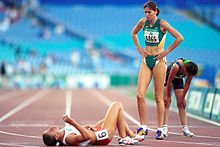
Parasports are sports played by people with a disability, including physical and intellectual disabilities. Some parasports are forms of adapted physical activities from existing non-disabled sports, while others have been specifically created for persons with a disability and do not have a non-disabled equivalent. Disability exists in four categories: physical, mental, permanent and temporary. At a competitive level, disability sport classifications are applied to allow people of varying abilities to face similar opposition.

The Paralympic Games or Paralympics, also known as the Games of the Paralympiad, is a periodic series of international multisport events involving athletes with a range of disabilities. There are Winter and Summer Paralympic Games, which since the 1988 Summer Olympics in Seoul, South Korea, are held almost immediately following the respective Olympic Games. All Paralympic Games are governed by the International Paralympic Committee (IPC).

The Paralympic sports comprise all the sports contested in the Summer and Winter Paralympic Games. As of 2020, the Summer Paralympics included 22 sports and 539 medal events, and the Winter Paralympics include 5 sports and disciplines and about 80 events. The number and kinds of events may change from one Paralympic Games to another.
Cheating at the Paralympic Games has caused scandals that have significantly changed the way in which the International Paralympic Committee (IPC) manages the events.

Wheelchair racing is the racing of wheelchairs in track and road races. Wheelchair racing is open to athletes with any qualifying type of disability, including leg amputees, spinal cord injuries, and cerebral palsy. Athletes are classified in accordance with the nature and severity of their disability or combinations of disabilities. Like running, it can take place on a track or as a road race. The main competitions take place at the Summer Paralympics which wheelchair racing and athletics has been a part of since 1960. Competitors compete in specialized wheelchairs which allow the athletes to reach speeds of 30 km/h (18.6 mph) or more. It is one of the most prominent forms of Paralympic athletics.

The Winter Paralympic Games is an international multi-sport event where athletes with physical disabilities compete in snow and ice sports. The event includes athletes with mobility impairments, amputations, blindness, and cerebral palsy. The Winter Paralympic Games are held every four years directly following the Winter Olympic Games and hosted in the same city. The International Paralympic Committee (IPC) oversees the Games. Medals are awarded in each event: with gold for first place, silver for second, and bronze for third, following the tradition that the Olympic Games began in 1904.

Athletics has been contested at every Summer Paralympics since the first games in 1960. Men and women from all disability groups compete in the sport.

The Philippine Paralympic Committee (PPC), formerly known as Philippine Sports Association for the Differently Abled—National Paralympic Committee of the Philippines, is the national sports association for physically impaired athletes, tasked to spearhead developing sport competency for Filipino persons with disabilities. It is the Philippine National Paralympic Committee which is duly recognized by the International Paralympic Committee

Virtus Sport is a federation established in 1986 by Dutch athletic professionals to promote the participation of athletes with mental handicap in elite sports.
Disability sports classification is a system that allows for fair competition between people with different types of disabilities.
Para-athletics classification is a system to determine which athletes with disabilities may compete against each other in para-athletics events. Classification is intended to group together athletes with similar levels of physical ability to allow fair competition. Classification was created and is managed by the International Paralympic Committee (IPC), which is regularly published via its IPC Athletics Classification Handbook. People with physical, vision and intellectual disabilities are eligible to compete in this sport at the Summer Paralympics. The classification for this sport was created during the 1940s and for much of its early history was a medical condition based classification system. The classification system has subsequently become a functional mobility based one, and is moving towards an evidence-based classification system.
Para-swimming classification is a function-based classification system designed to allow for fair competition in disability swimming. The classes are prefixed with "S" for freestyle, butterfly and backstroke events, "SB" for breaststroke and "SM" for individual medley events. Swimmers with physical disabilities are divided into ten classes based on their degree of functional disability: S1, S2, S3, S4, S5, S6, S7, S8, S9 and S10. The lower number indicates a greater degree of impairment. Those with visual impairments are placed in three additional classes: S11, S12 and S13. One more class, S14, is reserved for swimmers with intellectual impairment. A final class, S15, is for athletes with hearing loss. Another Classification is S19 which is similar to S14. It differs because S14 swimmers have an Iq of below 75 whereas S19 swimmers have an Iq of above 75.

Para-snowboarding classification is the classification system for para-snowboarding. The sport originally called Adaptive Snowboard is now practiced by hundreds of athletes around the world. The International Paralympic Committee (IPC) defines three classes: SB-LL for athletes with a physical impairment affecting one or both legs, and SB-UL for athletes with a physical impairment affecting one or both arms who compete standing. The sport made its official Winter Paralympic debut in the 2014 Winter Paralympics in Sochi, Russia.

Para-Nordic skiing classification is the classification system for para-Nordic skiing which includes the biathlon and cross-country events. The classifications for Para-Nordic skiing mirrors the classifications for Para-Alpine skiing with some exceptions. A functional mobility and medical classification is in use, with skiers being divided into three groups: standing skiers, sit skiers and visually impaired skiers. International classification is governed by International Paralympic Committee, Nordic Skiing (IPC-NS). Other classification is handled by national bodies. Before the IPC-NS took over classification, a number of organizations handled classification based on the type of disability.

Para-archery classification is the classification system for para-archery used to create a level playing field for archers with a different range of disabilities. Governance in the sport is through the International Archery Federation. Early classification systems for the sport were created during the 1940s and based on medical classification. This has subsequently changed to a functional mobility classification with the exception of blind archery.

The United Arab Emirates sent athletes to the 2016 Summer Paralympics in Rio de Janeiro, Brazil, from 7 September to 18 September 2016.
T41 is disability sport classification for disability athletics. It is used in track athlete and has a sister classification F41 for field athletes. This is a classification for athletes with short stature.
Les Autres sport classification is system used in disability sport for people with locomotor disabilities not included in other classification systems for people with physical disabilities. The purpose of this system is to facilitate fair competition between people with different types of disabilities, and to give credibility to disability sports. It was designed and managed by International Sports Organization for the Disabled (ISOD) until the 2005 merger with IWAS, when management switched to that organization. Classification is handled on the national level by relevant sport organizations.
Intellectual disability sport classification is a classification system used for disability sport that allows people with intellectual disabilities to fairly compete with and against other people with intellectual disabilities. Separate classification systems exist for the elite athlete with a disability side affiliated with the Paralympic movement and Virtus, and the sports for all model affiliated with Special Olympics. People with intellectual disabilities have issues with conceptual skills, social skills and practical skills. They have IQs of 75 points or lower, limitations in adaptive behaviour and their disability manifested and was documented prior to turning 18 years of age.
Para-athletics in Cameroon is one of several sports that people with disabilities participate in, in the country. Competitors in the sport have represented their country in international competitions. Development of sport has also taken place locally as a result of international support.














